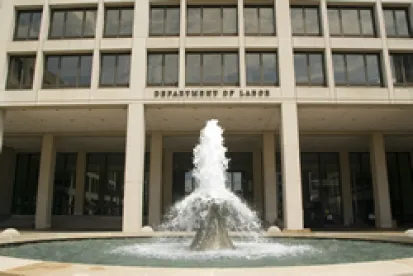Close Call. On November 21, 2019, President Donald Trump signed a continuing resolution to keep the federal government open through December 20, 2019. Given the pervasiveness of brinksmanship in Congress these days, the Buzz suspects that a new funding agreement won’t be struck (if at all) until the last minute.
Regulatory Agenda Released.
For D.C. policy wonks, this time of year isn’t only about turkey and stuffing; it’s often about the release of the administration’s fall regulatory road map. Well, on November 20, 2019, policy watchers had a lot to be thankful for, as the administration issued its Fall 2019 Unified Agenda of Regulatory and Deregulatory Actions. Set forth below are a few highlights of the administration’s regulatory forecast for the next six months or so.
U.S. Department of Labor
-
Wage and Hour Division (WHD)
-
Joint employer. A final rule is scheduled to issue in December 2019.
-
Regular rate. A final rule is scheduled to issue in November 2019.
-
Fluctuating workweek. The comment period closes on December 5, 2019.
-
Tip regulations. The comment period closes on December 9, 2019.
-
Family and Medical Leave Act (FMLA). In November 2019, the WHD expects to issue a request for information to “solicit comments on ways to improve its regulations under the FMLA to: (a) better protect and suit the needs of workers; and (b) reduce administrative and compliance burdens on employers.”
-
-
Office of Federal Contract Compliance Programs
-
TRICARE. The comment period closes on December 6, 2019.
-
Equal opportunity clause’s religious exemption. A final rule is scheduled to issue in March 2020.
-
Procedures to resolve discrimination. A notice of proposed rulemaking (NPRM) is expected in November 2019.
-
-
Occupational Safety and Health Administration (OSHA)
-
OSHA states it will initiate the Small Business Regulatory Enforcement Fairness Act process regarding its tree care standard (November 2019) and a potential standard addressing workplace violence in healthcare and social assistance settings (January 2020).
-
There is no significant update regarding potential changes to the existing lockout/tagout standard to address the impact of computer-based controls.
-
-
Employee Benefits Security Administration
-
Fiduciary rule. A notice of proposed rulemaking (NPRM) is scheduled to issue in December 2019. This effort resulted from the 2016 rulemaking that was vacated by the Fifth Circuit Court of Appeals in 2018.
-
Department of Homeland Security
-
United States Citizenship and Immigration Services (USCIS)
-
H-1B reform. In December 2019, USCIS is expected to issue a proposal to revise the definitions of “specialty occupation,” “employment,” and “employer-employee relationship,” as well as make additional changes “designed to ensure employers pay appropriate wages to H-1B visa holders.”
-
H-4 EAD. USCIS is forecasting that it will issue a proposal to “remove from its regulations” “certain H-4 dependent spouses of H-1B nonimmigrant workers” as a “class of aliens” eligible for employment authorization by the end of March 2020.
-
L-1 reform. By September 2020, USCIS states that it “will propose to revise the definition of specialized knowledge, to clarify the definition of employment and employer-employee relationship, and ensure employers pay appropriate wages to L-1 visa holders.”
Equal Employment Opportunity Commission (EEOC)
-
Joint employer. By December 2019, EEOC is scheduled to issue a proposal to “clarify when an entity is covered under the federal EEO laws as a joint employer.” This is certainly an interesting development, especially considering that the EEOC’s rulemaking authority under Title VII of the Civil Rights Act of 1964 is limited to procedural, recordkeeping, and reporting matters.
-
Pay report. By September 2020, the EEOC is scheduled to issue an advance notice of proposed rulemaking on a potential “rulemaking . . . that may include a new reporting requirement by which employers would submit pay data or related information.” Very interesting. This is the first time this proposal has appeared on the regulatory agenda.
National Labor Relations Board (NLRB)
-
Joint employer. Final action on the Board’s joint-employer proposal is scheduled for December 2019.
-
Access rule. By February 2020, the Board will purportedly issue a proposal “to establish the standards under the National Labor Relations Act for access to an employer’s private property.”
-
There are several proposed changes to election procedures.
-
First, comments on blocking charges, voluntary recognition, and 9(a) relationships in the construction industry are due by December 10, 2019.
-
Second, there are two separate entries for “Revision of Representation Case Rules.” One entry will specifically focus on the 2014 “ambush” election rule; a final rule on that matter is expected in November 2019. The other entry is scheduled to go final in January 2020, but it is unclear what will be addressed.
-
-
Proposed rulemaking on whether students who perform services for their colleges/universities are employees under the National Labor Relations Act. Comments are due by December 16, 2019.
NLRB Issues Ethics Report.
On November 19, 2019, the NLRB issued its Ethics Recusal Report. The report is a culmination of an 18-month-long effort to comprehensively address ethics and recusal issues stemming from the Board’s vacated Hy-Brand decision concerning the joint-employer standard. Among other conclusions, the report establishes a new filing obligation requiring all parties appearing before the Board to file an organizational disclosure statement. The report also adopts a written Board member disqualification protocol and determines that Board members can challenge the agency’s ethics official recusal determination and insist on participating in a particular case (though this, according to the report, should be very rare).
House Passes Workplace Violence Bill.
On November 21, 2019, the U.S. House of Representatives passed the Workplace Violence Prevention for Health Care and Social Service Workers Act (H.R. 1309). The bill requires OSHA to issue an interim workplace violence prevention standard covering healthcare and social assistance industries. While over 30 Republicans voted in favor of the bill, most Republicans—including the White House—expressed concerns that it undercuts the rulemaking process. The bill is unlikely to advance in the U.S. Senate.
Kangaroo Court.
There has been a lot of talk in D.C. recently about kangaroo courts, and this got the Buzz wondering about the etymology of the term. Of course, it has nothing to do with marsupials dispensing justice. While there is no definitive answer, there are some theories on how “kangaroo court” became part of our lexicon. Some say the phrase started during the California Gold Rush, when miners dealt with “claim jumpers.” Another theory dates back even further, to the mid-1830s, when a neighborhood in Vicksburg, Mississippi, called Kangaroo became known for meting out extrajudicial justice. Still others attribute the term to traveling judges on the U.S. frontier, who hopped from town to town in effort to wrap up as many trials as possible. Whatever the case, the Buzz is sure of one thing: “kangaroo court” sure as heck has nothing to do with a children’s television program.




 />i
/>i

